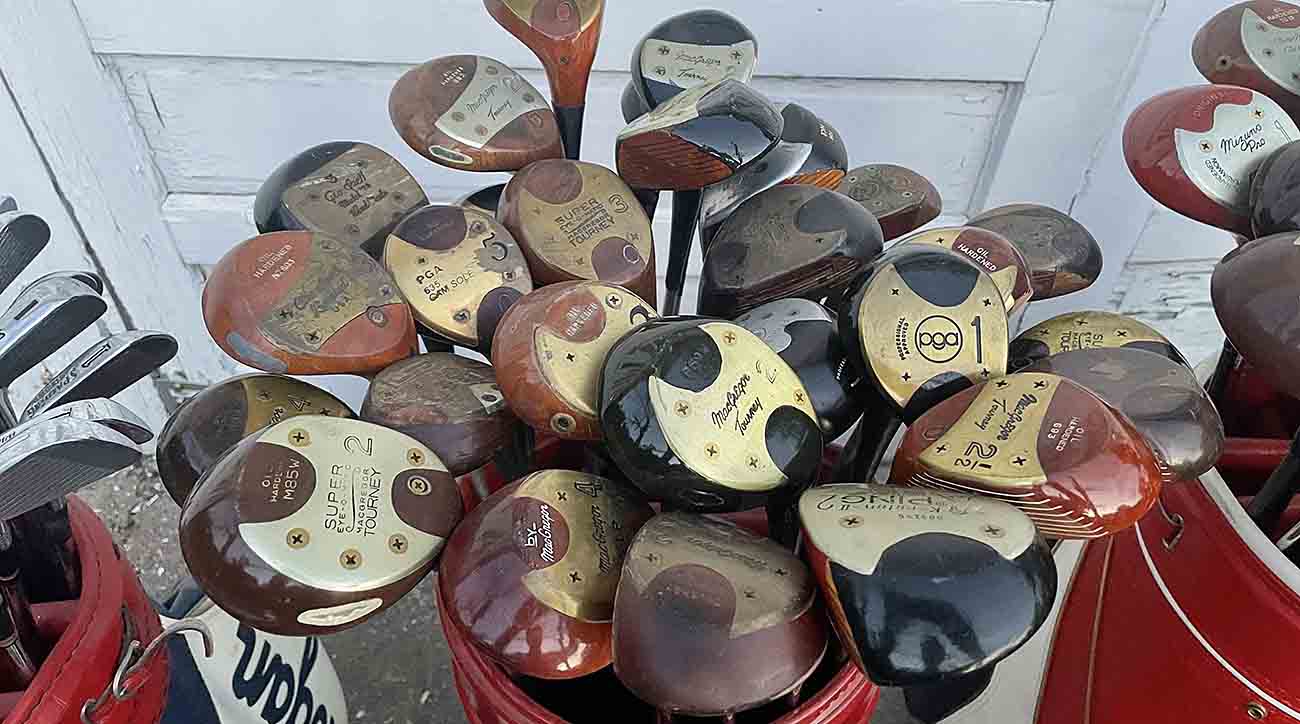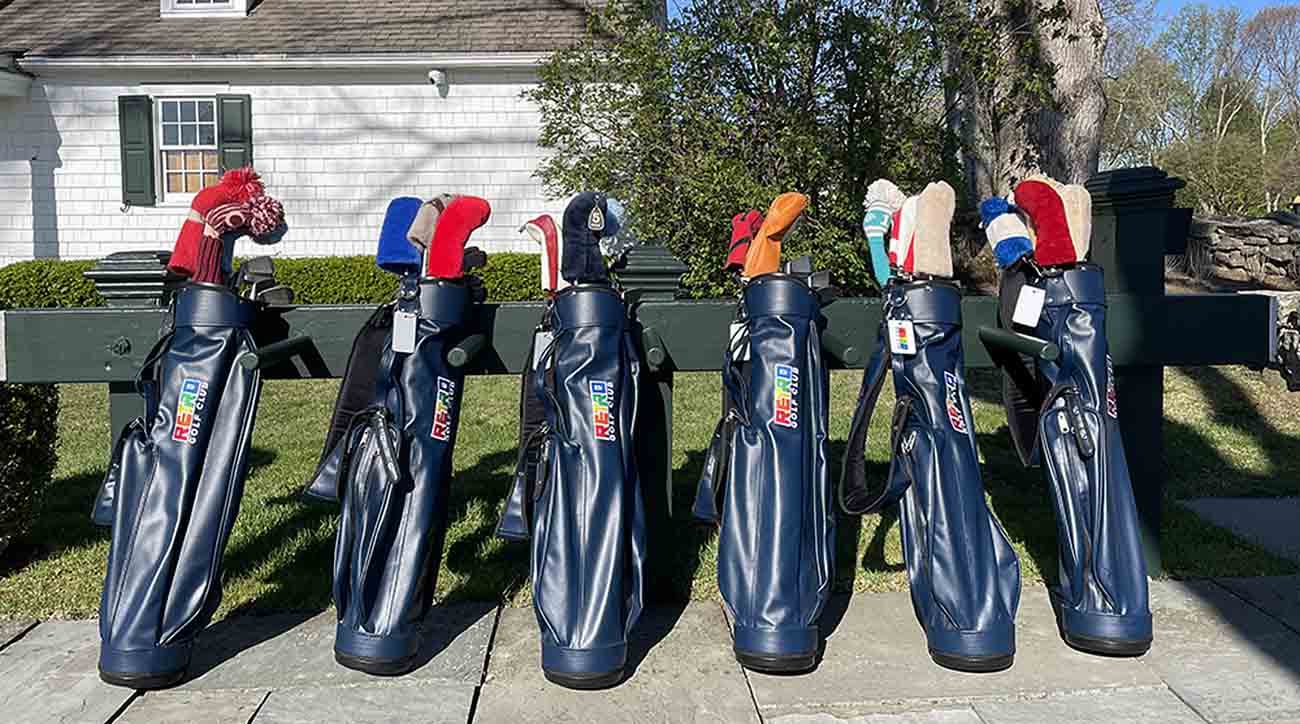There Are Rental Golf Sets, Then There Are Retro Golf Rental Sets

Once upon a time in golf, there was no sweeter sound than a persimmon driver smacking a balata golf ball. And it felt as sublime and soft as a kiss.
These days, our high-tech, oversized metal heads deliver more distance, yes, but louder. Think Metallica versus persimmon’s Simon and Garfunkel.
You can relive the joy of persimmon—or try it for the first time, perhaps—thanks to Retro Golf Club. It has 100-plus sets of persimmon woods and forged blades available for rental. It’s a way to turn back time (without using a DeLorean) for a unique retro golf outing. Call it the Greatest Hits of the 1970s and ‘80s, minus the Doobie Brothers and Phil Collins.

Cory Crelan, who lives near New York City, is the man who turned his retro golf club collection into a specialty golf business. Crelan is a golf professional and a graduate of Ferris State University’s golf management program and has been in golf sales for 20 years. He founded Retro Golf Club so people can remember their roots—their golf roots, not the dyed ones on their heads. (You know who you are.)
We asked a few questions of the Retro King:
Sports Illustrated: Did you collect all these clubs recently or did you travel back in time to get them?
Cory Crelan: No, Michael J. Fox wasn’t on my staff.
SI: You should have hired him.
CC: Probably. It has been a tremendous amount of work. I’ve got 106 full sets and plenty more assorted clubs. And I’ve got those old Jones carry bags. Our tagline is, “The premier lifestyle event celebrating the ‘70s and ‘80s.” We’re almost splitting hairs whether clubs are from the ‘60s or ‘70s. The equipment was largely the same for a very long time.
SI: I’m picturing you in a condo with 106 sets of retro clubs filling up all the rooms you used to live in. Am I right?
CC: Well, I am in a condo but the clubs are stored at Retro Golf Club headquarters, a storage area. I frequent it almost every night. It’s just one town over and it’s a good change of pace to get out of the house, hop in the car for 10 or 15 minutes and clear my head by working on the clubs.

SI: It sounds like you’re seriously hooked.
CC: I had all of the clubs out in the yard at the garage one weekend and this lady who lived up the road walked by and said, “I see you here but it’s only at night and on weekends.” She wondered what I was doing with all those clubs.
SI: And you said, “Hi, I’m Jordan Spieth, nice to meet you!”
CC: I didn’t. But walking into the garage really is like a time machine trip into a 1980 country club back room. If you’re familiar with old equipment, you know a lot of those clubs and many of those clubmakers are no longer in business. It’s surprising, like telling a junior golfer now that TaylorMade wasn’t going to be around in 25 years.
SI: Do you look for specific clubs to collect?
CC: Tour players always tried to find old Toney Penna drivers back then because he made very nice driver heads. They knew sooner or later the wood on their own drivers was going to crack. So they had to have a replacement. Persimmon heads didn’t last forever.
SI: Each driver, even from the same company, wasn’t identical, either. A manufacturing rep would bring 10 drivers of the same model to a tour pro. He’d hit 10 and only like maybe two.
CC: Exactly. When a tour pro had a wood he liked, he didn’t switch. You’d have to literally pry it out of his hands. It’s not like today, where models change every few years and there’s a constant churn.
SI: So what was the inspiration that made you think, hey, I can make these clubs I collected into a business?
CC: There were several things. When I was maybe 7 years old, my dad bought a set of woods and a new set of Hogan Apex irons, which were top-of-the-line clubs. They cost real money. I’d guess at least $500 or $600 at the time. He would shoot 85 to 95 and just wanted to own quality clubs. There weren’t a lot of game-improvement options. He was a lifelong golfer and moved on to modern clubs but he always kept those Hogans. He passed away a dozen years ago. My mom called and said, hey, come take all this golf stuff. I put the old Hogans in a bag and stored them in my attic, which wasn’t much different than what my mom had done.
SI: The attic is easier and less painful than tossing them in the garbage.
CC: Definitely. So I went to play this old time course in Connecticut—Hotchkiss. And I decided to use some old-time clubs—my dad’s retro set. It was really fun. I loved it. Curiosity got the best of me after that. I went on eBay and started looking for the persimmon clubs I remembered from when I was a kid. A month later, there was a listing for a whole slew of old clubs by a friend of a friend. I drove my Mercedes to Manhattan’s Lower East Side to see them.
SI: With your retro theme, shouldn’t you have been driving a Studebaker or a Gremlin or something?
CC: Well, some guy’s father-in-law passed away and he must have been a serious player. He had exquisite taste in clubs. He had 50 woods, 40 sets of irons, some heel-shafted 8802 putters—maybe 30 different brands of clubs. I bought them all for $200, which was cheap. I filled my car. I thought, This is an opportunity. Over time, my goal became 100 sets of retro clubs because if you’re at a club, a large outing is at least 100 golfers. Later, I bought a collection that belonged to a 40-year Spalding employee. I filled a Suburban that I borrowed.

SI: I think you mean a Ford Edsel.
CC: Right. I had to make a second trip with my own car and wow, I had far exceeded my original goal. But a lot of the old clubs were dirty, they needed cleaned and polished and the grips were the consistency of concrete. I probably regripped 1,300 clubs that winter and cleaned, polished and refinished many of the irons. It was a lot of work.
SI: So that’s when the business came into view?
CC: Yes, I realized I could utilize my network of golf pros and courses from 20 years of selling equipment to convince people this was a fun idea for golf outings. It coincided with COVID and every course’s golf activity level took off. All these clubs had member-guest events and they were looking for something different. I’m not a persimmon evangelist, I just think it’s an overlooked option.
SI: What kind of golf balls do you use with these retro clubs?
CC: If you can find balata balls from that era, they’re worth more than the clubs. The going rate for a dozen is about $100.
SI: Wow.
CC: Balls are a non-issue, really. Any low-compression ball works. I like to use Wilson Duo balls, which are just over $20 a dozen.
SI: Do golfers at your outings complain about losing distance?
CC: Not really. You play a course from 6,100 yards, the distance doesn’t hinder anyone. I just hope to start a conversation about using these classic clubs. People are scared by the idea. If I tossed you the keys to a 1980 Porsche 911, would you take it for a drive? Of course you would. You wouldn’t need to be a single-digit handicap driver to drive that car. Is the 1980 Porsche 911 prettier than the current model? I’d say yes. Anyone can use this era golf equipment as long as you’re not playing tee markers at 7,000 yards.
SI: I still have a persimmon 1966 Walter Hagen driver. I had it refinished in the 1990s, took it out to play at the Yale Golf Club once and was quickly reminded that when you don’t hit the sweet spot, a drive loses 20 or 30 yards of distance. It looks tiny mixed in with my old metal woods.
CC: There’s another undercurrent going on. Vinyl records are outselling CDs for the first time in 30 years. A vinyl record is not superior to a digital recording. But putting the record on a turntable, setting down the needle—it’s the total experience that people like. Are my retro clubs a little harder to hit? Of course. But it’s all about the total retro experience.
SI: How does someone book your retro clubs for an outing?
CC: Just go to the website (RetroGolfClub.com) or find us on Instagram. I’m based near New York City, I drive the clubs to wherever I need to get them. It’s not cost-effective to ship them so I only do bookings in New England, New York, the Mid-Atlantic and some of the Midwest.
SI: I guess you don’t need a DeLorean to travel back in time.
CC: No, you don’t. There’s something about the sound of a persimmon club and the feel of hitting the sweet spot on a blade iron that you can’t get from today’s high-tech clubs. Also, I just like looking at the retro clubs. It makes me happy.
